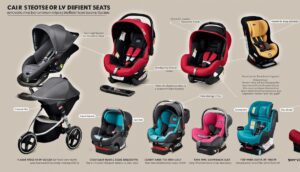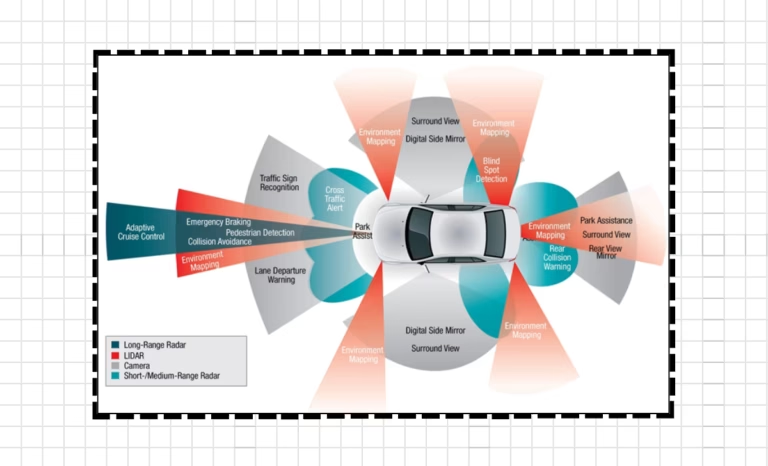Child safety is a paramount concern when driving, and an essential component of this is selecting and using the right car seat. Each child’s age, height, and weight, as well as the specific features of your vehicle, should inform your choice. There’s an extensive range of car seat types available, including infant car seats, convertible car seats, all-in-one car seats, and booster seats. Each type comes with particular weight and height restrictions, and unique advantages and inconveniences.
Moreover, the selection and purchase process should not only take into account the child and vehicle requirements, but also aspects such as the car seat’s quality, expiration dates, any potential recalls, and safety standard compliances.
In this article
In this article
Understanding Car Seat Types
Understanding Car Seat Types
Car seats are an essential part of ensuring child safety while on the road. Understanding the various types available in the market is a basic step in securing your child’s safety.
Infant Car Seats
Infant car seats, as the name suggests, are designed specifically for newborns and infants. They’re rear-facing seats and typically support babies from birth until they weigh about 22 to 35 pounds, and are 29 to 32 inches tall. They usually come with a base that stays in the car and a detachable seat that can be carried around, offering convenient mobility. A leading advantage of infant car seats is that they fit newborns perfectly and provide optimal safety. However, the downside is that infants quickly outgrow these, necessitating an upgrade to a bigger seat within the first or second year.
Convertible Car Seats
Convertible car seats are versatile and designed to grow with your child. They can be used as both rear-facing and forward-facing car seats. Rear-facing, they can accommodate babies from 5 pounds to 40-50 pounds, depending on the model. When switched to forward-facing, they can typically handle toddlers up to 65 pounds and up to 49 inches tall. They offer longevity and help parents save money since you won’t need a new seat until your child outgrows it. But, they can be bulky and do not offer the convenience of portability like the infant seats.
All-In-One Car Seats
All-in-one car seats, or 3-in-1 car seats, offer three modes of use: rear-facing, forward-facing, and a booster seat. They can accommodate a child from birth until they no longer need a car seat, generally around 100 pounds. This makes them the most economical option in the long run. However, experts suggest newborns may not fit as well or be as well-protected in 3-in-1 seats as in infant seats.
Booster Seats
Booster seats are the final step in the car seat journey. They are designed for children who have outgrown their forward-facing seats, typically those weighing 40 to 80 pounds, and are less than 4 feet 9 inches tall. Booster seats “boost” a child up in your vehicle’s seat to correctly position the seat belt across their chest and hips. They are generally easier to install, and some models can even be converted into a backless booster for older kids.
Before diving into the vast variety of car seat types, safety must be your utmost concern. It is essential to ensure that the car seat you opt for, regardless of its style or model, adheres to the safety regulations outlined by the National Highway Traffic Safety Administration (NHTSA). The most high-priced car seat isn’t automatically the best option; rather, the seat that fits your child’s stature, installs correctly in your car, harmonizes well with your vehicle, and is consistently used every time you hit the road essentially makes it the superior choice.

Photo by hillcountry_camera on Unsplash
Selection and Purchase of Car Seats
Types of Car Seats Demystified
Car seats come in a multitude of types, each uniquely designed to cater to the varied age, weight, and height of children. Particularly suited for newborns and tiny infants are rear-facing car seats, owing to the enhanced head, neck, and spine support they offer. When your little one starts to grow, convertible car seats come into action, effortlessly shifting from rear-facing to forward-facing. Booster seats come in handy for older kids until they are big enough to fit perfectly into the vehicle’s seat belt. Then there’s the all-in-one car seat capable of transforming into all the afore-mentioned configurations, albeit being somewhat large and possibly difficult to accommodate in compact vehicles.
Also, Read: Exploring the World of Fastest Motorcycles: Speed, History, and Safety
Factors to Consider in Car Seat Selection
When selecting a car seat, it is crucial to consider the child’s age, height, and weight. Car seats are designed to accommodate different stages of a child’s growth, and using the wrong type of car seat can compromise a child’s safety. The vehicle type is another important aspect, as not all car seats fit in all vehicle models. In some cases, you might require a relatively narrow car seat if your vehicle is smaller. The quality of the car seat also matters. Always opt for car seats that meet all federal safety standards.
Checking the Expiration Date and Recalls
Car seats are generally manufactured with an expiration date that ranges from six to ten years from the manufacturing date. After the expiration, the car seat’s structural integrity may diminish, which could be risky in a collision. Additionally, stay informed about any product recalls, as there can be manufacturing defects or safety issues identified after the car seat has been sold.
Evaluating Safety Standards and Testing
In the United States, car seats must meet Federal Motor Vehicle Safety Standard (FMVSS) 213, which covers performance criteria during a collision. These standards ensure that the seat belt, the seat buckles, and all the attachments are sturdy and durable. For further assurance, look for car seats that have undergone independent crash testing and have information available on their crash performances.
Finding the Right Car Seat: New Purchases and Second-Hand Options
Searching for a new car seat? You can easily find them through various channels such as in-store retailers, online platforms, department stores, or directly from the manufacturers. However, if your budget leans towards a second-hand seat, it’s crucial to confirm that it hasn’t been recalled or expired, has never been involved in any accident, and comes complete with all the necessary parts as well as its original instruction manual. The seat must also comply with FMVSS safety standards. Lack of such information or if the history of the seat is doubtful, it’s best to skip the purchase. Remember, even though cost-effectiveness matters, nothing is more important than your child’s safety when buying a car seat.

Photo by senjuti on Unsplash
Installation and Safety Issues
Installing a Car Seat: Making Use of the LATCH System and Seat Belt Installation
Once you’ve chosen the perfect seat, the next crucial step is its correct installation in your car. The two major installation methods for car seats are the LATCH system and the seat belt method, both suitable despite the car model or seat type.
The Lower Anchors and Tethers for Children (LATCH) system facilitates a sturdy attachment of car seats without needing the car’s seat belts. It functions by linking hooks from the seat onto metal anchors within the vehicle, while the tether, attached to the top of the seat, connects to another anchor in your car. Make sure to refer to your car’s manual to locate the correct LATCH anchor points.
The seat belt installation, on the contrary, entails channeling the car seat belt through a specific pathway detailed in the seat’s manual. This method might be a tad bit more complex than the LATCH system, potentially demanding more physical strength to achieve a secure fit. There could also be some errors when shifting the seat between vehicles. Therefore, it’s essential to lock the seat belt to consistently maintain tension and keep the car seat in place.
Common Installation Mistakes to Avoid
Proper use of car seats involves not only correct installation but also avoiding common mistakes that could compromise safety. Here are some examples:
- An incorrectly positioned car seat: The seat should not move side to side or front to back by more than an inch once installed. You should check for a secure fit at the belt path.
- Not using the top tether on forward-facing car seats: The top tether should be used even if you install the seat using the seat belt method as it greatly reduces forward head movement in a crash.
- Incorrect recline angle: Each car seat has a specific angle at which it should recline, and failure to do so could lead to dangerous situations. Refer to the car seat’s manual for guidance.
Ensuring Your Child’s Safety: Registering Your Car Seat
To guarantee your child’s safety when traveling, utilizing a proper car seat is tantamount. A key safety measure often overlooked is registering the car seat with the manufacturer. In the event of a product recall due to discovered faults that may pose safety risks, registering your seat ensures you’ll receive direct notifications. This allows you to act promptly and decisively to maintain your child’s safety. You can register your car seat either online or by mail using the registration card included with the product.

Photo by marcnoorman on Unsplash
Effective Use and Maintenance
Ensuring Secure Seat Buckling for Car Seats
In the continuum of car seat safety, secure buckling techniques are just as crucial. Strict adherence to the manufacturer’s instructions provided with your car seat is crucial. Notably, harness straps should lie flat without any twists. Also, depending on the design of your car seat, the buckle and chest clip should align with your child’s armpit to ensure an ideal fit. The harness should fit snugly, with no extra material to pinch at the shoulder. Avoid dressing your child in bulky clothing as it can obstruct correct harness adjustment.
Correct Positioning in Car Seats
Proper positioning is another critical aspect of car seat safety. For babies who can’t sit up unaided, the car seat should be set at a 45-degree angle. This semi-reclined position supports the child’s head and back, and helps prevent breathing difficulties. As your child grows, adjustment may be needed. Always reserve the use of pillows or blankets to adjust a child’s position for newborns or under the advice of a healthcare professional. Care should be taken to ensure the child’s head doesn’t flop forward or to the side excessively, which can restrict their airway.
How and When to Adjust Car Seats
It is crucial to adjust car seats according to your child’s changing needs. Change from rear-facing to forward-facing, and eventually to booster seats, should be based on your child’s weight, height, and age. Contrarily, the comfort level and fitting of the harness may need adjusting as your child grows. Follow the car seat manual’s guidelines, and check your state’s Department of Motor Vehicle rules for legally required specifications on car seat adjustments.
Cleaning and Maintenance of Car Seats
Cleaning and maintaining a car seat prolongs its life and ensures its effectiveness. Always refer to your car seat manufacturer’s instructions for the approved cleaning method. Some covers can be machine-washed, while others must be cleaned by hand. Some parts may need occasional lubrication. Never use harsh cleaners, bleach, or solvents, as this can weaken the car seat material. Regularly check the harness, buckle, and adjuster for wear and damage. Remember not to submerge straps or webbing in water, as this can weaken the fibers and compromise safety.
Lastly, car seats have an expiration date, commonly around six years from manufacture. Regularly checking the condition of the car seat and adhering to this expiration date will ensure your child’s safety.

Securing your child safely in your vehicle extends beyond just selecting the right car seat model. Proper installation, whether using a LATCH system or seat belt method, is critical. Awareness and avoidance of common mistakes while installing can make a significant difference. Registering your car seat can further enhance safety by keeping you informed about recalls. Not to be overlooked is the proper use and regular maintenance of the car seat, which ensures comfort even as it safeguards your child.
Buckling techniques, positioning, cleaning, and knowing when to adjust the seat are all part of responsible car seat usage. Always remember, a well-informed and diligent approach towards car seat selection, installation, and maintenance is fundamental to on-road safety for your child.




